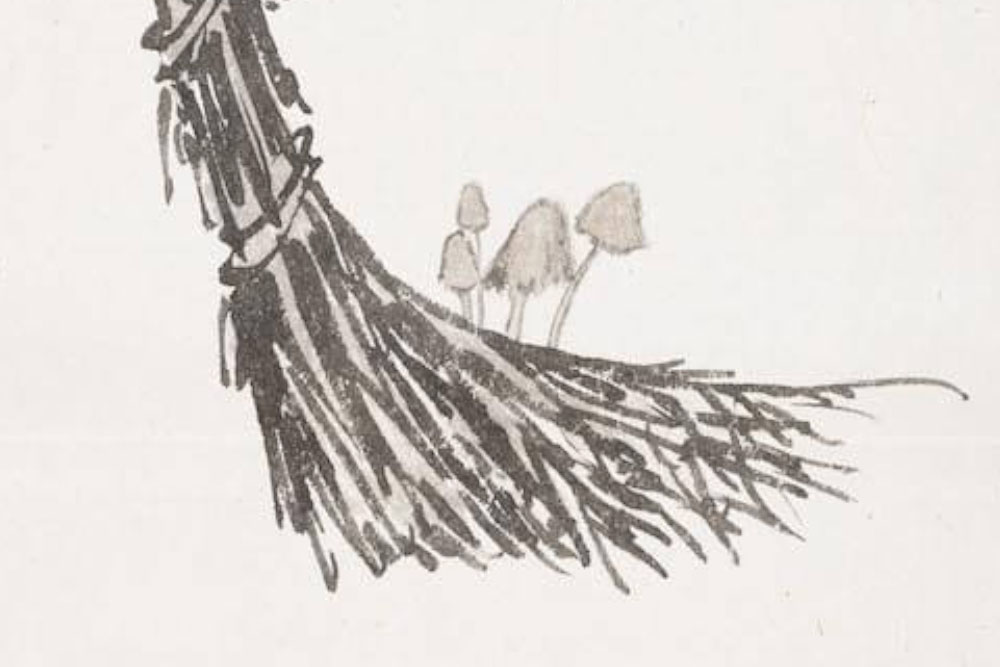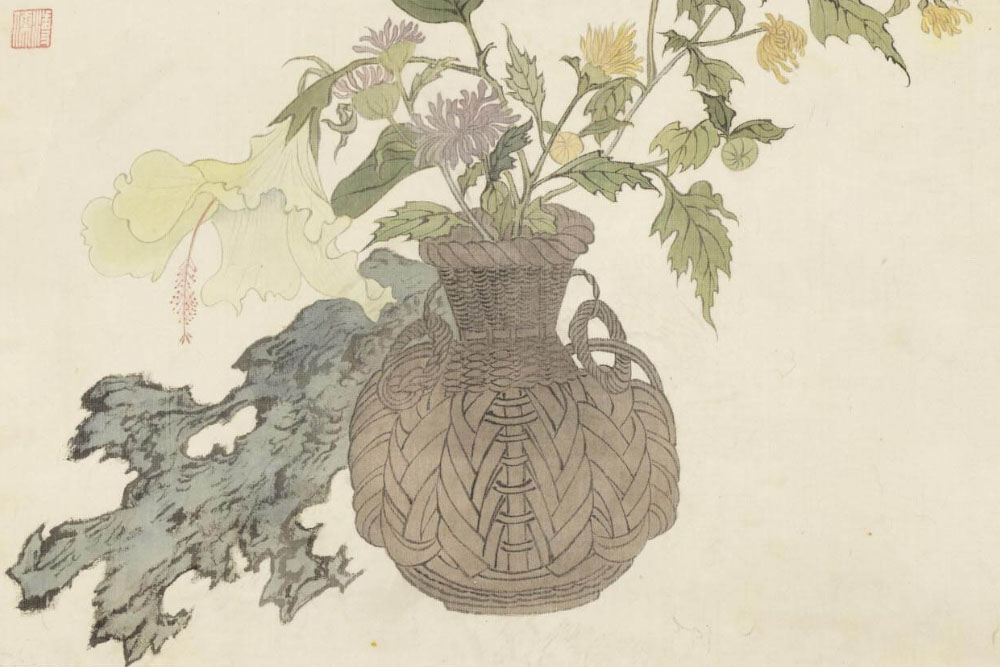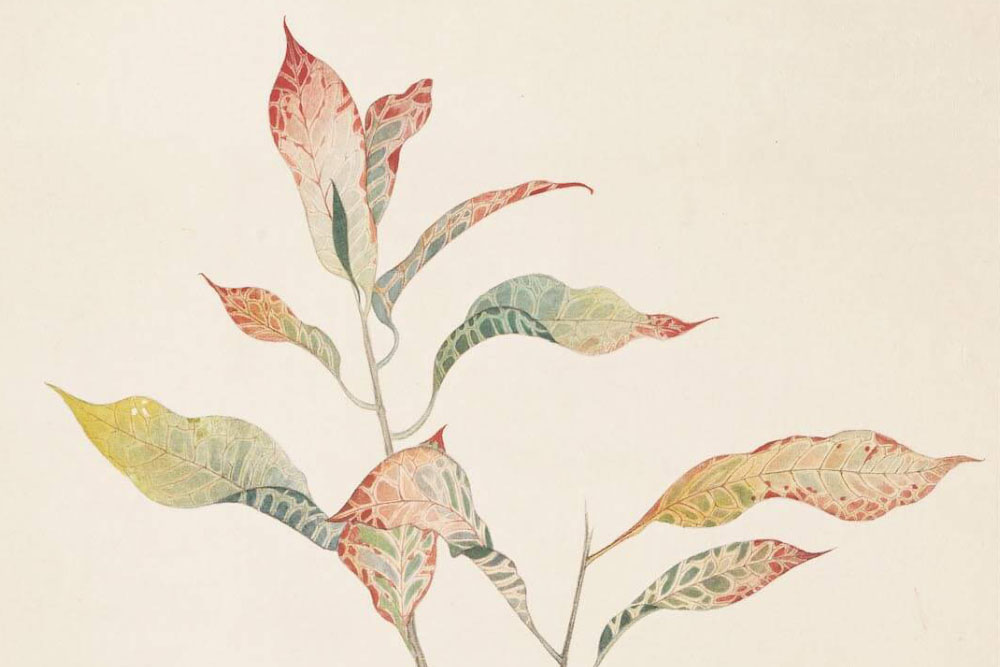Selected Facets of Formosa
Although Pu Hsin-yu resided in Taipei during his life in Taiwan, he often traveled to famous sites around the island in his spare time from teaching. As a result, he left behind a considerable number of sketched paintings of the places he visited and the things he saw.
For a painter with deep roots in tradition, there are not necessarily established practices when it comes to sketching from life. In the case of Pu Hsin-yu, he had to not only simulate the subject before his eyes but also grasp the forms and nature of it, all the while retaining the strong brushwork and pure coloring of his typical style. His range of Taiwan subjects include scenery, figures, fruits and vegetables, flowers, and animals. Particularly representative works include "Scene of Snow at Jade Peak," "Aborigines Hunting a Deer," "Fish and Shrimp," "Vegetables in Color," "Ode on Garden Croton," and "Sea Rock." In addition to painting, many of these works also feature an inscription to lodge his feelings and impressions, thereby further demonstrating Pu's incomparably pure and untrammeled mind.
- Broom Growing Mold
- Pu Hsin-yu (1896-1963), Republican period
- Hanging scroll, ink and colors on paper, 56.6 x 30.2 cm
- Entrusted from the Cold Jade Hall
With his keen sense of observation, Pu Hsin-yu was able to transform even mundane aspects of everyday life into the subject of his poetry and painting. After arriving in Taiwan from the mainland, one year he suddenly came across an old broom leaning against the wall during the rainy season in March, which had started to grow mold because of the humidity. Lamenting its fate, he wrote an elegy and did the accompanying illustration in this work to lodge his feelings about the old broom representing the sorrows of his unfulfilled potential as a remnant of the dynasty of old and of not being able to return to his hometown. Mounted with the painting is an inscription by the poet Chang Chao-ch'in (1873-1962) dated to 1953.
- Ornamental Rock and a Flower Basket
- Pu Hsin-yu (1896-1963), Republican period
- Hanging scroll, ink and colors on silk, 44.6 x 37.9 cm Entrusted from the Cold Jade Hall
Judging from the inscription on this work, Pu Hsin-yu apparently based it freely on a display in front of his table. He placed a bluish-green eroded rock from the seashore next to a bamboo basket containing autumn flowers. The artist delicately rendered the weaving and structure of the basket, reminding the viewer of a flower basket painting by the Southern Song artist Li Song (1170-1255). However, the Li Song work is full of fresh and colorful flowers, while Pu Hsin-yu's features just a few sprigs of chrysanthemums and hibiscus, revealing the refined essence of the literati approach to painting.
- Ode on Garden Croton
- Pu Hsin-yu (1896-1963), Republican period
- Hanging scroll, ink and colors on paper, 66 x 37.2 cm
- Entrusted from the Cold Jade Hall
A shrub known as garden croton is commonly seen in Taiwan, and Pu Hsin-yu's rendering here reminds one of the bird-and-flower style of Qian Xuan from the late Song and early Yuan period. Pu used light ink strokes to delineate the outlines and veins of the leaves and then added layer upon layer of various light colors to build up the forms and create a seemingly natural "boneless" effect of washes without lines. The airy and elegant beauty of this painting is complemented by Pu's own composition of "Ode on Garden Croton" in small regular script that reveals his appreciation of this plant and his ability to lodge feelings in this subject matter both in literary and painterly terms.
- Aborigines Hunting a Deer
- Pu Hsin-yu (1896-1963), Republican period
- Horizontal scroll, ink and colors on silk, 13.3 x 96.8 cm
- Entrusted from the Cold Jade Hall
In the short height of this painting, Pu Hsin-yu has depicted in brush and ink a few rocky outcroppings with several trees. Standing out near the top of the outcropping to the left is a stag as three aborigines are shown individually making their way among the trees toward it on the hunt.
The brushwork throughout the painting is refined with the coloring light and elegantly untrammeled. Not only does the style follow in the tradition of Northern Song landscape painting, it also reflects the artist's lofty purity of the literati. This work was probably done not long after Pu Hsin-yu arrived in Taiwan in 1949. The difference between what he was used to on the mainland and what he saw in Taiwan might have spurred him to do the painting, which also represents a vignette from aboriginal life and a vivid record from that time.
- Snow Scene at Jade Peak
- Pu Hsin-yu (1896-1963), Republican period
- Handscroll, ink and colors on paper, 13.3 x 96.8 cm Entrusted from the Cold Jade Hall
Despite being titled as a snow scene, the white snowy mountains here extend only to the middle section of the painting, giving rise to rugged mountains with trees that recede from the foreground to nearly fill the entire surface. From the inscription, we learn that Pu Hsin-yu did not portray a straightforward snow scene, but instead the scenery of Taiwan during winter. Little snow falls in Taiwan due to the tropical heat, except for its highest mountains, which are instead mostly green all year round. At the end of the scroll to the left and below the inscription are several small trees in an imagined glimpse of snowy scenery at Jade Peak. Because "the mountains and streams are deep and dangerous as well as inaccessible," Pu Hsin-yu was only able to lodge his ideas in painting from the imagination.









